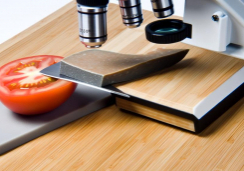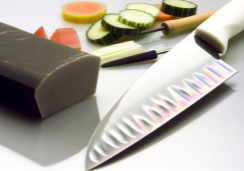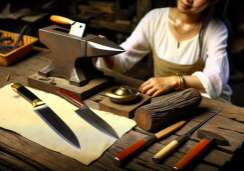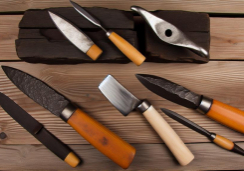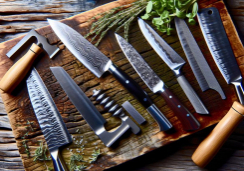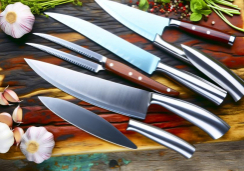9 Tips to Keep Ceramic Kitchen Blades Sharp
Your ceramic kitchen knives are the culinary workhorses, always ready to tackle the next slicing task with precision and ease. But just like a trusty steed needs proper grooming to perform at its best, your blades require regular maintenance to remain sharp and effective.
It's essential you're not cutting corners when it comes to caring for these delicate yet formidable tools. From selecting the right cutting surfaces that won't dull your knives to mastering the honing technique that ensures a long-lasting edge, each step is crucial.
In the following lines, you'll uncover the secrets to keeping your ceramic knives in top condition, including some professional tips that might just surprise you. But remember, a sharp knife is a safe knife, and what lies ahead could transform your culinary preparation from frustrating to flawless.
Use Proper Cutting Surfaces
To maintain the edge of your ceramic kitchen blades, always use a cutting board made of softer materials such as wood or plastic, rather than hard surfaces like stone or glass. It's crucial to understand that the molecular composition of ceramic blades, formed from zirconium dioxide, makes them incredibly hard and less prone to dulling than their metal counterparts. However, this same hardness renders them more brittle and susceptible to chipping.
When you're selecting a cutting board, opt for those designated as 'knife-friendly.' Wooden boards offer a self-healing property, where the fibers close back after the knife edge passes through them. Bamboo, while technically a grass, also presents a good balance of durability and gentleness on knife blades. Plastic boards, specifically high-density polyethylene (HDPE), provide a softer surface that minimizes blade dullness.
Avoid marble, granite, or tempered glass cutting boards. They're aesthetically pleasing but can blunt your ceramic knife's edge with repeated use. Moreover, the impact on these hard surfaces can cause microchipping along the blade's edge, diminishing its sharpness and potentially leading to larger fractures.
Mind your cutting technique as well. Gentle, straight cuts and avoiding twisting or prying movements will protect your blade's integrity. Remember, the longevity of your ceramic knife's edge directly correlates with the care you exercise in choosing the proper cutting surface.
Avoid Hard Foods
While selecting the appropriate cutting board is essential for preserving your ceramic knives, it's equally important to be mindful of the types of food you're slicing, as hard foods can quickly dull or damage the blade. Ceramic knives are crafted from zirconium dioxide, which undergoes a process called sintering to achieve its renowned hardness. However, this hardness is accompanied by brittleness, making the knives susceptible to chipping when they encounter foods with a high degree of resistance.
You should avoid using your ceramic knives on frozen foods or bones. These materials present a high risk of causing microchips along the cutting edge or even larger fractures in the blade. Instead, reserve your ceramic knife for softer, fleshier foods, like fruits, vegetables, and boneless meats. When it comes to tasks that require cutting through tougher materials, opt for a steel knife that can handle the stress without sustaining damage.
Furthermore, it's not just about avoiding damage—preserving the sharpness of your ceramic blade is a matter of maintaining its precision. Each time you press down on a hard surface or food, you risk blunting the fine edge. By reserving your ceramic knife for the appropriate tasks, you'll extend its sharpness and enjoy the full range of benefits it offers in your culinary preparation.
Store Safely
Ensuring your ceramic knives remain sharp hinges on adopting secure storage practices.
You'll need to invest in quality knife sheaths specifically designed for ceramic blades to prevent edge damage.
Additionally, consider blade-friendly storage solutions that keep knives separate and immobilized to mitigate risk of chipping.
Proper Knife Sheaths
Always store your ceramic kitchen blades in a proper knife sheath to guard against dulling and chipping. Opt for sheaths designed with a soft interior lining; this minimizes abrasion, maintaining the blade's razor-sharp edge. Ensure the sheath fits snugly—too loose, and the blade may shift, risking edge damage, too tight, and you risk chipping the blade when inserting or removing it.
Avoid generic sheaths that aren't tailored to your knife's specific dimensions. A customized fit reduces the risk of premature wear. Furthermore, select materials that resist moisture buildup, as trapped humidity can compromise the structural integrity of the ceramic.
Always insert the blade gently into the sheath, keeping the cutting edge aligned with the protective interior to maximize longevity.
Blade-Friendly Storage Solutions
After selecting the right sheath for your ceramic kitchen blades, consider the overall storage environment to further protect their sharpness and integrity.
You'll want to avoid tossing these knives into a crowded drawer where they can come into contact with other utensils. Instead, opt for a dedicated knife block with horizontal slots. This design minimizes stress on the blades' edges, preventing dulling and chipping.
Alternatively, magnetic knife strips offer a space-efficient solution, provided the magnetic pull isn't excessively strong, which might damage the ceramic. Ensure that the strip is installed away from potential impacts.
Lastly, if you're using a drawer, in-drawer knife mats or custom-built slots lined with soft materials can safeguard your blades.
Precise storage practices extend the life of your ceramic knives, keeping them razor-sharp for your culinary tasks.
Clean Appropriately
You must select gentle washing techniques to maintain the integrity of your ceramic blades.
Ensure you're using the right cleaning agents that won't corrode or dull the blade's surface.
Improper cleaning can quickly degrade a blade's sharpness, compromising its performance and longevity.
Gentle Washing Techniques
To maintain the edge of your ceramic kitchen blades, it's essential to employ gentle washing techniques that prevent abrasive damage to the cutting surface.
After use, rinse the blade under lukewarm water to remove debris. Avoid hot temperatures which can cause micro-fractures.
Apply a mild detergent with a soft sponge, moving parallel to the edge to minimize wear. It's crucial to steer clear of harsh scrubbers or steel wool, as they can degrade the blade's integrity.
Thoroughly rinse off soap residue as it can corrode the blade over time.
Finally, dry your ceramic knife immediately with a soft towel to prevent water spots and potential edge erosion.
Adhering to these steps ensures your blade's longevity and sharpness.
Right Cleaning Agents
While ensuring your ceramic knives are dried properly to maintain sharpness, it's equally important to select the correct cleaning agents that won't compromise the blade's integrity. Opt for mild, non-abrasive detergents. Harsh chemicals, like chlorine or bleach-based cleaners, can dull the knife's edge and cause micro-abrasions on the ceramic surface. This deterioration not only reduces performance but also shortens the lifespan of your utensils.
It's best to avoid the dishwasher, where potent detergents and high-pressure water can damage the fine edge. Instead, gently hand-wash your ceramic knives using a soft sponge or cloth. Rinse thoroughly with warm water to remove any detergent residue that could potentially degrade the blade over time.
Hone Regularly
Regular honing is crucial to maintain the razor-sharp edge of your ceramic kitchen blades. While traditional steel knives often require honing before each use, ceramic blades demand less frequent but still regular attention due to their hardness and brittleness. You'll need to use a honing rod that's specifically designed for ceramic knives, as conventional steel honing rods can damage the delicate edge of your ceramic blades.
Begin by placing the tip of the honing rod on a non-slip surface, holding it vertically with your non-dominant hand. With your dominant hand, grasp the handle of the knife and place the blade against the rod at the appropriate angle, which is typically a 20-degree angle for ceramic knives. Gently slide the blade down the rod, moving from the heel to the tip of the knife, while maintaining consistent pressure and angle.
Repeat this process around four to six times per side of the blade to realign any microscopic bends or nicks.
Professional Sharpening Techniques
After honing your ceramic kitchen blades regularly, you may find they eventually require the expertise of a professional sharpener to restore them to their optimal cutting edge. A professional understands the subtle intricacies of ceramic material and uses specialized equipment to achieve a razor-sharp finish without compromising the blade's integrity.
When selecting a professional sharpening service, ensure they employ advanced techniques that cater specifically to ceramic blades:
- Diamond Abrasives: Professionals often use diamond-coated wheels or belts, as diamond is one of the few materials harder than ceramic, ensuring efficient and precise sharpening.
- Controlled Sharpening Angles: Precision is key, and professionals maintain a consistent angle throughout the sharpening process, typically between 18 to 20 degrees for ceramic knives, to ensure an even edge.
- Customized Sharpening Approach: Each blade's condition is assessed, and a customized sharpening strategy is applied, taking into account any chips or nicks that may require special attention.
Rely on a professional's skill to maintain your ceramic knives' balance, sharpness, and longevity. They'll employ a combination of mechanical sharpening and hand finishing techniques for a superior edge that retains its sharpness longer.
Avoid Twisting Motions
To maintain the integrity of your ceramic kitchen blades, avoid using twisting or lateral motions during cutting, as these can create undue stress on the delicate edge. Ceramic blades, composed of zirconium dioxide, are renowned for their sharpness and hardness; however, they aren't as flexible as their steel counterparts. Twisting motions can cause microchipping or even complete breakage of the blade.
When you're chopping, dicing, or slicing with a ceramic knife, use a straight up and down motion. This technique ensures that the force you apply is distributed evenly and directly down the blade, minimizing lateral stress. It's essential to apply a consistent, vertical pressure and to avoid any side-to-side movement that could compromise the blade's structural integrity.
Moreover, be mindful of the cutting surface you're using. A hard surface, like glass or metal, can blunt the ceramic edge swiftly. Opt instead for a wooden or plastic cutting board, which provides a softer landing for the knife and absorbs some of the impact during cutting.
Use Correct Cutting Techniques
While refining your slicing skills, it's crucial to employ the correct cutting techniques to preserve the sharpness of your ceramic kitchen blades. Ceramic knives are engineered for precision and delicacy, thus they demand an informed approach to cutting that maximizes their longevity.
- Use a Gentle Sawing Motion: Ceramic blades perform optimally when used with a gentle back-and-forth motion. This technique reduces sideways stress on the edge, preventing chipping or cracking.
- Straight Cuts Only: To maintain the integrity of the blade, always cut straight down. Avoid twisting or turning motions that can compromise the ceramic material.
- Proper Surface Selection: Always use a cutting board that's softer than the blade, such as wood or plastic. Hard surfaces like glass or stone can dull the ceramic edge quickly.
Ensure that you're applying only the necessary pressure during each cut. Overbearing force isn't only ineffective but also detrimental to the blade's edge. The lightweight nature of ceramic knives is designed to provide an effortless cutting experience, so let the sharpness of the blade do the work.
Handle With Care
Handle your ceramic kitchen blades with the utmost care to prevent damage to their finely honed edges. Ceramic blades are crafted from zirconium oxide, a material that's harder than steel but more brittle. This means while they can retain a sharp edge for longer periods, they're prone to chipping or breaking if mishandled.
When using ceramic knives, avoid twisting or flexing the blade. Such lateral forces can compromise the structural integrity of the ceramic, leading to micro-fractures or complete failure. Always cut straight down and lift the knife back up. Don't use these blades for prying or cutting semi-frozen foods, as the hardness of the material doesn't accommodate such stress.
Store your ceramic knives in a knife block or a sheath specifically designed for ceramic blades to protect their edges. Don't toss them into a crowded kitchen drawer where they can knock against metal utensils or other knives. Such collisions can dull the edge or cause chips. If possible, dedicate a specific storage spot for your ceramic knives to avoid any contact with objects that could compromise their sharpness.
How Can I Prevent Ceramic Kitchen Blades from Losing Their Sharpness?
To prevent ceramic kitchen blade edge loss, avoid cutting on hard surfaces like stone or glass. Use wooden or plastic cutting boards instead. Clean and dry the blades immediately after use to prevent rust. Store the knives in a knife block or on a magnetic strip to protect the edges.
Conclusion
In conclusion, here are the steps to maintain the edge of your ceramic blades:
- Choose the right cutting surfaces and avoid hard foods.
- Store the blades securely and clean them with care.
- Hone the blades consistently to preserve sharpness.
- Consider professional sharpening when needed.
- Avoid twisting motions and practice proper cutting techniques.
- Handle your ceramic knives with the attention they deserve.
By following these precise steps, you'll ensure your kitchen blades remain in top condition, ready for your culinary endeavors.

